Bagger Battle: Harley-Davidson Road Glide Special Vs. Indian Challenger Limited

The young upstart takes on the legend in a gunfight along Route 66
When we think of baggers, we think V-Twin engines. Yes, there are some exceptions, the BMW K1600B and the Moto Guzzi MGX-21 (with its unusual transverse V-Twin) come to mind, but aside from those outliers, baggers from all manufacturers are solidly in V-Twin land. However, with the chassis, a couple of choices exist. Do you want a fork-mounted or frame-mounted fairing? In the frame-mounted category, there is one, big-daddy model that dominates the class, the Harley-Davidson Road Glide. For 2020, the grizzled veteran has been called out by a young gun that wants to prove its mettle. The Indian Challenger clearly has its sights on the Road Glide. In a classic battle reminiscent of the Old West, these two gunslingers have stepped onto the street, and the outcome will be determined on Route 66.
Because we were planning on spending a couple of long days in the saddle on these baggers, it’s only natural that I looked to my Iron Butt compatriot, Tom Roderick, for this comparison. The route selected by the John Burns Travel Service had a good mix of interstate, rural highway, and mountain twisties. John also joined us on an Indian Chieftain so that he could act as the second rider in the photos and video. Should this motojournalism thing not work out for him, we’re confident John could find a good home in the motorcycle hospitality business.
Get the Flash Player to see this player.
Really, though, we designed this comparo to center on what these two bikes were designed for – short-hop, weekend touring where you can travel light. In that regard, both bikes performed exactly as expected, delivering the creature comforts and gear storage we needed. In the trim provided by the manufacturers, both the Harley-Davidson Road Glide Special and the Indian Challenger Limited are in the $28,000 range. [Update: A YouTube viewer pointed out that the Harley’s Reflex Denfensive Rider System is a $995 option, making the Road Glide $745 more expensive than the Challenger. The new price is $29,494. – Ed.] Hang on for what looks to be an exciting test between the new kid and the old guard.
Engine Compartment
What we have here is a face-off between a descendant of the old-school air-cooled 45° V-Twin that has roamed the highways for over a century and a brand new liquid-cooled engine. Despite the Harley Milwaukee-Eight’s air-cooling, it is a thoroughly modern power plant. The 114 cubic-inch displacement of our test unit is the largest non-CVO engine available from the Motor Company, and we’ve had nothing but good things to say about the M8 since its inception. It has managed to straddle the divide between its historic construction and the demands of modern emissions requirements. The annual bumps in displacement have only given riders more to love.
The Challenger steps in with a 108 cubic-inch 60° V-Twin engine, but don’t let that displacement deficit confuse you. While it’s 108 mm x 96.5 mm bore and stroke may start with less volume per bang than the Road Glide’s 102 mm x 114.3 mm, it has some tricks atop its sleeves. Namely, the Indian eschews pushrods for SOHC to operate the four valves per cylinder, meaning it has a higher redline. So, where the Milwaukee-Eight starts to run out of gas, the Indian’s PowerPlus keeps on spinning – and the dyno charts show the results.
This difference becomes the defining contrast between the engines. Yes, the PowerPlus is liquid-cooled, but that factor goes unnoticed from the saddle (except that the heat wafting off of the Indian’s rear cylinder in stop-and-go traffic is diminished). Where the Harley likes to grunt it out in the low rpm, riding the torque curve, the Indian – despite its displacement disadvantage – makes more hp and torque from the get-go and keeps building its advantage throughout the rpm range. Still, this is about more than numbers. This difference affects the character of the engines.
Tom sums up his feelings: “A few top-gear roll-ons proved the Indian to be the faster motorcycle, but its superior power makes no difference to me as I prefer Harley’s engine over the Indian’s any day of the week. The type of riding for which the Road Glide is designed, the 114 cubic-inch Milwaukee-Eight is the perfect Twin. At 80 mph the Harley’s mill spins at a leisurely 3,000 rpm whereas the Indian’s shorter-stroke engine runs 500 rpm higher. Regardless of the speed, though, the Indian’s Twin always feels frenetic, as if it’s working hard and wants you to know it. Comparatively, the Harley Twin lopes along getting the job done working in the background with just enough vibe and noise to let you know it hasn’t run out of gas.”
Here is where Tom and I part company regarding the engines. I didn’t mind the more mechanical feel of the PowerPlus engine, and I loved the additional oomph. If the Indian had less torque than the Harley, I might feel differently about the business of the engine. As it stands, my choice is the Indian.
We’ll call this category a tie, as all of the other factors in the engines were fairly equal. Both had slick-shifting transmissions, and their EFI tuning was glitch-free.
Rider Aids
For a first in this category of motorcycles, both bikes receive state-of-the-art safety technology in the form of lean-sensitive traction control and ABS. While the manufacturers refer to them by different names, the job they do is essentially the same.
On the Challenger, a six-axis Bosch IMU powers Indian’s Smart Lean Technology traction control and lean-sensitive ABS, taking the dynamic conditions of the bike into account when intervening to maintain traction under braking or acceleration. Harley delivers similar functionality under the name of Reflex Defensive Rider Systems.
While most people might think of this technology as being for sportbikes, it plays an important role in keeping touring riders safe, too. Think of a situation where you’re rounding a corner, and you see something in your lane. Lean-sensitive ABS will help save you from an over-application of brakes brought on by the surprise or the necessity to do a panic stop. Similarly, it’s not uncommon to encounter times when traction is limited due to rain or a slick substance on the road – a situation where the rear wheel can step out under acceleration. Traction control serves a real-world purpose here, too.
In addition to the above technology, both bikes limit the back-torque applied to the rear wheel during an abrupt downshift. Since large-displacement Twins can easily lock the back wheel with compression braking, both the Harley and Indian use electronic drag-torque control to more closely match the engine braking to the road speed.
Both bikes performed identically in deliberate ham-fisted downshifts and attempts to initiate the traction control. This category is a tie.
Chassis and Suspension
While you’ll never forget that you’re riding a big, heavy, long motorcycle, both of these bikes handle the twists of any tarmac you encounter when you stray from the freeway. You can hustle them through the curves with surprising alacrity. Where some big bikes feel like work on a circuitous road, the Challenger and the Road Glide are fun. The same can be said of them when cranked over in a high-speed sweeper where they feel planted and rock steady. When cruising along on the interstate, both bikes are dead stable. These bikes are made to rack up the miles.
Although the Challenger felt the heaviest lifting it off the side stand, both bikes mask their 800+ pounds well once rolling. Even at parking lot speeds, these baggers feel quite balanced, with the length of the rider’s arms being the only limitation in tight, slow maneuvers.
However, when it comes to handling road irregularities, these bikes differ – sharply. The Road Glide’s suspenders prefer smooth pavement. Get them out of their comfort zone, and… well, we’ll just let Tom take over:
”For a bike costing $28 large the H-D’s suspension performance is nearly inexcusable. The Harley transmits every road imperfection first to the rider’s hands via its traditional fork arrangement, then a second time to their posterior via the dual shocks. Outside of upselling an individual some of Harley’s own upgraded suspension components, I fail to see why Harley can’t provide a better functioning fork and shocks.”
I agree with Tom wholeheartedly. At times I even found myself tensing up in anticipation of the jolt of a bump I saw coming. Additionally, the Harley’s suspension didn’t feel balanced fore and aft, leaving them to react differently to bumps and occasionally upsetting the chassis.
The Challenger, as I noted at the beginning of this comparo, was clearly designed with the Road Glide in mind. Indian obviously studied the Harley with an eye towards addressing some of the bike’s weaknesses in what could be described as a loving interpretation of the Road Glide. The Challenger’s suspension features a non-adjustable inverted fork and a solo shock with a hydraulic preload adjuster. The difference with the Harley’s suspension is shocking. Rather than seeming to dance to different songs over bumps, the Indian’s suspension works together to swallow the bumps and maintain chassis composure.
Tom chimes in: ”The Challenger rolls off the showroom floor on suspension worthy of its price tag. The fork and shock work in unison to absorb bumps and potholes while maintaining comfort for the rider. Harley, take note, this is how suspension should work on a bike costing $28k!l
Advantage Challenger.
Rider Comfort
When it comes to coddling the rider as the miles roll by, both of these baggers are well above average. The riding positions of both bikes were remarkably similar, with the primary difference being the handlebars. The Challenger’s grips were lower and wider, which presented a problem in tight, low-speed maneuvers, making the rider’s arm length, rather than steering lock, the limiting factor. With the Road Glide, the grips were a little higher and closer together, making them more comfortable out on the open road and an ideal width for U-turns. While we are considering the grips, it should be noted that heated grips are an accessory option on both bikes.
The seats were split the opposite way. In this case, the Road Glide’s bucket seat limited the rider to one position, and as the miles racked up, this limited seating developed hot spots in our calibrated testing apparatus. Tom’s notes say, ‘The Road Glide may have the more comfortably-bent handlebars, but the Indian certainly boasts the more comfortable seat. Other ergonomics being similar, my posterior never seemed to need a break when riding the Challenger.” The Challenger’s seat offered both more room and better lower back support for the long haul. On our final five-hour stint, I could have made it all the way home without a break if I hadn’t needed to stop for gas. I was always ready for a change after an hour on the Harley.
I’ll let Tom introduce the next comfort feature on the list: ‘If you’re concerned about the gimmickiness of the Indian’s electronic windscreen you and I are equally skeptical individuals. After two days and hundreds of miles, I found the Challengers windscreen to be a welcome advantage over the Harley. In fact, on the dark, cold ride home I was cursing Evans for sitting comfortably in the bubble it creates while I was exposed to the desert’s decreasing ambient air temperature over the course of our five-hour return trip home.” The advantages of the adjustable windscreen are twofold. First, it does help keep the rider warm as the temperature drops, but then, in hot weather, lowering the screen allows more air flow to cool the rider. Also, riders who are sensitive to buffeting can adjust the height to fine tune the turbulent air at highway speeds.
This round goes to the Challenger.
Touring Amenities
You can bet that we’d be up in arms if these two touring bikes didn’t have cruise control. But they do, and they work well.
The infotainment system on touring bikes is a vitally important feature, giving everything from location and directions to a variety of communication options. Both bikes have stereo systems that work fine at low speeds, but in my opinion, lack the clarity of using Bluetooth helmet communicators at highway speeds. This comes down to a matter of personal preference, and you know if you like blasting loud music on the road. If you do, the Challenger, like all similarly equipped Indians, has a volume control that goes to 11, for This is Spinal Tap fans.
Both bikes use their TFT screens to control various features of the infotainment system, but the Challenger has the ability to use the controls on the left handlebar in addition to the touch screen. Both Tom and I found this to be quite helpful. The multitude of screens on the Indian deliver much more information, though some of it is relatively useless. On the positive side, the rider also has the ability to design what information is displayed on the various screens. While the software the Harley was running may not have been as flexible, I found its screen to be easier to read in direct sunlight.
Tom’s notes on the subject: ”Both bikes are equipped with fancy computers and full-color screens, but the Indian certainly provides as much, if not more, pertinent information to the rider in a layout that’s easy to read at a quick glance while riding at speed. The Challenger’s interface between bike and rider is also more intuitive and easy to operate, which maybe isn’t saying much if you’re a believer in having two turn signal switches.”
Other thoughtful details, such as the electronic saddlebag locks, give the Challenger a more modern feel compared to the Road Glide, which gives the impression that the convenience features were designed in conjunction with the rest of the motorcycle instead of worked into a previous design.
The Challenger chalks up another win.
Styling, Fit, and Finish
Since the Road Glide has been around for quite a while, Harley has had the luxury of refining and polishing it to a high sheen. In every styling area, the Glide outshines the Indian. Where the Challenger’s fairing looks overly large and somewhat bulbous, the Road Glide’s lines are harmonious from front to rear. The bodywork between the Challenger’s seat and the saddlebags with its flat, uninspiring plastic offers a prime example. Still, we have to praise Indian’s decision not to tart up the engine with a mess of faux cooling fins and letting the engine’s liquid cooling play a role in its style. Still, there is an openness in the Harley’s frame around the engine that both Tom and I found appealing.
Tom’s take: ”Visually, I prefer the Road Glide’s profile. It’s look is understated, but every feature seems appropriately sized; a well balanced and pleasant-to-view motorcycle from saddlebag to front fairing. Parked next to the Harley the Challenger seems top-heavy due to its over-sized fairing, while it’s densely-packed chassis resembles a barn door on wheels, lacking any of the nooks and crannies that give the Harley its more traditional appearance.”
While the paint quality on both bikes is high, the Harley’s satin finish steals the show, capturing the light to highlight the bodywork’s curves. Yes, the Road Glide wins this round.
As the Dust Settles on a Western Highway
In this test, both bikes brought their A-game, and both scored well. You’d think by the way the Challenger won so many of the above sections that it would be a runaway win on the scorecard. Or at least I did, but I was wrong. When we sat down to think about it, the scoring in each category was fairly close. Still, the Challenger eked out a 2.4% advantage when the scorecard was complete.
Tommy-boy sums up his view: “Going into the Scorecard I presumed the Indian would win on points, but I was pleasantly surprised to look at my subjective scores and see the Challenger’s advantage over the Harley-Davidson to be a scant half-point (113.25 vs. 112.75, respectively). For me, the near-tie outcome represents how closely matched these two bikes are and what a tough decision I’d have were I forced to choose between them.
“Alas, the Indian did win largely on the merits of its superior suspension and the comfort provided by its electronic windscreen. However, if your tax bracket affords you the luxury of purchasing one of these two motorcycles and you’re attracted to the Harley, I suggest going with your heart and spending a little more to upgrade the HD’s suspension, purchase a comfy aftermarket seat, a taller windscreen and Bob’s your uncle.”
Tom and I split on which bike we would choose. For me, it was the functionality of the Challenger that won me over. The engine appeals to me, and there is no contest between the suspensions. My only real complaint about the functionality of the Challenger is the handlebar, but that is a relatively easy fix. My feelings about the styling are less glowing. Still, I could live with it in a pinch.
So, congratulations to the Indian Challenger. It defeated the OG fixed-fairing bagger. While the results may have been extremely close, this is quite an accomplishment for a first-generation motorcycle. Our theory is that Indian’s designers looked long and hard at the Road Glide, taking the best characteristics and improving where necessary, leaving the Challenger on top when the dust settled.
Bagger Battle Scorecard | ||
|---|---|---|
Harley-Davidson Road Glide Special | Indian Challenger Limited | |
Price | 97.5% | 100% |
Weight | 98.6% | 100% |
lb/hp | 83.0% | 100% |
lb/lb-ft | 94.9% | 100% |
Total Objective Scores | 95.0% | 100% |
Engine | 87.5% | 87.5% |
Transmission/Clutch | 81.3% | 85.0% |
Handling | 83.8% | 85.0% |
Brakes | 83.8% | 85.0% |
Suspension | 77.5% | 88.8% |
Technologies | 90.0% | 91.3% |
Instruments | 86.3% | 90.0% |
Ergonomics/Comfort | 88.8% | 87.5% |
Luggage/Storage | 87.5% | 91.3% |
90.0% | 90.0% | |
Cool Factor | 87.5% | 82.5% |
Grin Factor | 78.8% | 82.5% |
Evans’ Subjective Scores | 84.0% | 87.3% |
Tom’s Subjective Scores | 86.7% | 87.1% |
Overall Score | 87.2% | 89.6% |
Bagger Battle Specifications | ||
|---|---|---|
Harley-Davidson Road Glide Special | Indian Challenger Limited | |
| MSRP | $28,499 | $28,749 |
| Engine Type | Twin-cooled, Milwaukee-Eight 114 45° V-Twin, 1868cc | Liquid-Cooled SOHC 60˚ V-Twin; 4 valves/cylinder, 108 cu in (1769 cc) |
| Bore and Stroke | 102 mm x 114.3 mm | 108 mm x 96.5 mm |
| Fuel System | Electronic Sequential Port Fuel Injection (ESPFI) | Electronic fuel injection, closed loop/52 mm dual bore |
| Compression Ratio | 10.0:1 | 11.0:1 |
| Valve Train | Pushrods, 4 valves per cylinder | SOHC, 4 valves per cylinder |
| Transmission | 6-speed | 6-speed/constant mesh |
| Final Drive | Belt | Belt |
| Front Suspension | 49mm conventional fork | Inverted telescopic fork, 43 mm diameter, 5.1 in (130 mm) travel |
| Rear Suspension | Dual emulsion-style shocks, hydraulically adjustable preload on left shock. | Single shock 4.5 in (114 mm) travel, hydraulic adjustable |
| Front Brake | Dual 320mm, four-piston calipers | Dual 320 mm floating rotors with 4-piston calipers, ABS |
| Rear Brake | 320mm, four-piston caliper | Single 298 mm floating rotor with 2-piston caliper, ABS |
| Front Tire | BW 130/80B17 65H | Metzeler Cruisetec, 130/60B19 66H |
| Rear Tire | BW 180/65B16 81H | Metzeler Cruisetec, 180/60R16 80H |
| Rake/Trail | 26° / 6.7 in. | 25° / 5.9 in. |
| Wheelbase | 64.0 in. | 65.7 in. |
| Seat Height | 29.0 in. | 26.5 in. |
| Curb Weight | 847 pounds | 835 pounds |
| Fuel Capacity | 6 gal. | 6 gal. |
| Available Colors | Vivid Black, River Rock Gray, Billiard Red, Barracuda Silver Denim, Scorched Orange/Silver Flux, Zephyr Blue/Black Sunglo | Titanium Metallic, Thunder Black Smoke, Sandstone Smoke, White Smoke, Thunder Black Pearl, Deepwater Metallic, Ruby Metallic |

Like most of the best happenings in his life, Evans stumbled into his motojournalism career. While on his way to a planned life in academia, he applied for a job at a motorcycle magazine, thinking he’d get the opportunity to write some freelance articles. Instead, he was offered a full-time job in which he discovered he could actually get paid to ride other people’s motorcycles – and he’s never looked back. Over the 25 years he’s been in the motorcycle industry, Evans has written two books, 101 Sportbike Performance Projects and How to Modify Your Metric Cruiser, and has ridden just about every production motorcycle manufactured. Evans has a deep love of motorcycles and believes they are a force for good in the world.
More by Evans Brasfield



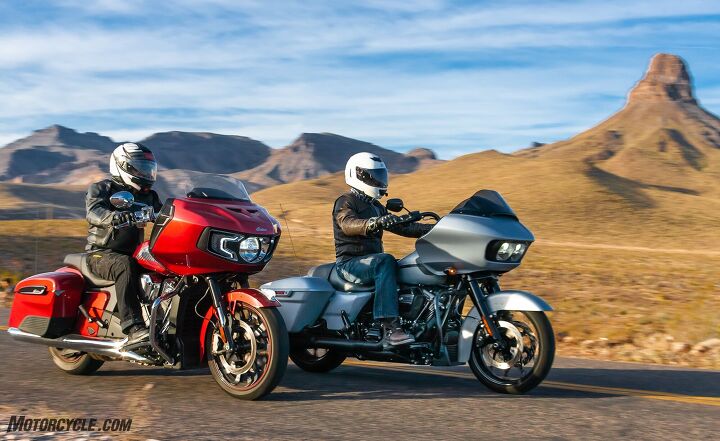
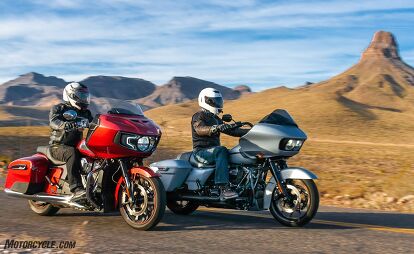






































































































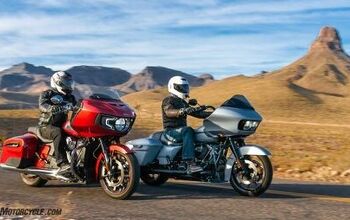
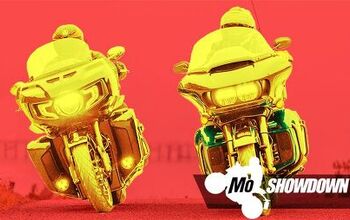



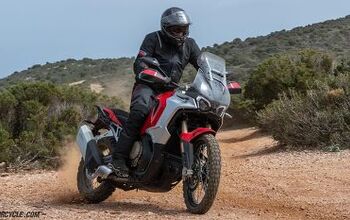










Comments
Join the conversation
seems cycle world's dyno is optimistic compared to yours.
Hands down, my Chieftain is the best motorcycle I have owned. It is upgraded to the Big Bore Kit and is smooth and responsive. Its incredible "retro-future" looks are a head turner and think it has so much more to offer than a Harley (my biased opinion). The other side is that Indian riders will wave and acknowledge you when you ride-Harley riders go out of their way to ignore you. :)